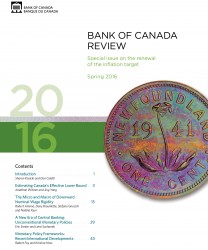Bank of Canada Review - Spring 2016
This issue focuses on the upcoming renewal of Canada’s inflation-control target. Bank researchers discuss the estimate of the lower bound to policy interest rates in Canada. They also discuss downward nominal wage rigidity and whether its presence warrants considering a higher inflation target. The third article highlights the experience some international central banks have had with unconventional monetary policies. The final article describes monetary policy frameworks in 10 advanced economies.
The Bank of Canada Review is published twice a year. Articles undergo a thorough review process. The views expressed in the articles are those of the authors and do not necessarily reflect the views of the Bank.
The contents of the Review may be reproduced or quoted, provided that the authors and the publication, with its date, are specifically cited as the source.
